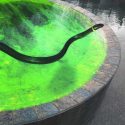This is one of the most beautiful tropical islands on Earth, but the view comes at a high price. You’d have to deal with giant riptides, hungry great white sharks, and what is that thing growling behind the trees? What did you get yourself into?
The most dangerous beach in the world is located on Fraser Island, on the southeastern coast of Queensland, Australia. Its Butchulla name is K’gari, which means paradise. Sure, this island earns its nickname with its breathtaking scenery. But it can turn into a purgatory fast. Its 120 km (74.5 mi) length is a minefield of dangers. Water predators, rainforest beasts and even the sand itself could be lethal. There may not be lifeguards to help, so you’re on your own this time.
Could you outswim a riptide? Which creature could eat your child? How could vinegar save your life?
Step 1. Don’t Pet the Dogs
If you see a cute dog roaming across a beach, don’t try to pet it. It’s a dingo. These wild animals scavenge for leftovers that dirty humans leave on the beach. Dingoes are curious, and they’ll investigate human camps, especially if you leave food out. Dingoes are highly aggressive toward humans and have a history of attacking little kids.
Step 2. Beware the Underwater Killers
If you’re brave enough to dip your toes in these waters, keep your eyes open. You could encounter the biggest, most dangerous water predator, even in shallow waters. Standing face-to-face with a great white shark is something straight out of your nightmares. But, as unbearable as it sounds, you shouldn’t panic. Stay still. Splashing water as you try swimming away would only attract the shark, and you can’t outswim it.
A great white might be easy to spot, but this tiny killer might not be. Its bell is no bigger than 20 mm (.78 in) in diameter, and the Irukandji jellyfish is the world’s most venomous box jellyfish. If this cutie stings you, you’ll feel the most excruciating pain and could have trouble breathing. Drenching the wound with vinegar for 30 seconds or more could help neutralize the venom before it’s too late.
Step 3. Watch the Waves
Now that you handled the wild things that want to eat you, you have to deal with something that can drown you.
Since you can’t rely on beach flags or lifeguards being nearby, you’ll have to look for signs of a riptide. They’re quite common around Fraser Island. Staring at the waves for a few minutes will help you identify one.
Riptides will look like dark spots in the water moving in the opposite direction of the other waves. And they’ll have a rippled surface surrounded by still water. If you find yourself trapped in a riptide, try to remain calm and don’t try swimming to shore. You’ll never outswim a riptide.Instead, swim parallel to the shore and toward breaking waves.
Step 4. Don’t Drive
While you’re on the most dangerous beach of all, maybe you should leave your vehicle behind. These sandy beaches could cause drivers to wipe out, roll over and have head-on collisions. In 2018, a group of tourists decided to drive their Range Rover along the beach, but a high tide waterlogged the sand and rolled the car over. The people got out of the vehicle quickly, but it couldn’t be removed for a few days. By then, the sand had covered most of the overturned car.
Step 5. Find a Creek
Keep in mind that you’re on a remote island. If you get hurt, you won’t be able to get medical help there. Maybe you should stay out of the shark-infested waters. You can swim in Eli Creek inside the island. It has clear freshwater that you can enjoy. Or try Lake McKenzie, which is surrounded by tea trees. Their oil is said to heal aches and pains, and the water is free of jellyfish. You survived the dangers of Fraser Island, and now you’ve developed a taste for treacherous travels.
The next stop on your list is the Devil’s Pool. Take one wrong step here, and you could plummet 108 m (354 ft) to your death. If you don’t want that to happen, keep watching How to Survive.
Sources
- “What Is A Rip Current?“. 2022. Oceanservice.Noaa.Gov.
- “People-Dingo Interactions | K’gari (Fraser Island), Great Sandy National Park“. 2022. Parks And Forests | Department Of Environment And Science, Queensland.
- “What Is The Most Dangerous Beach In Australia?“. 2019. Beaches Of Australia, Beach Fun, And Things To Do.
- “Whitsundays Stinger Season – Sailing Whitsundays“. 2022. Sailing Whitsundays.
- “Fraser Island Travel Guide | Things To Do In Fraser Island, Queensland“. 2022. Fraser Island Tours.
- “Fraser Island Tourists Flip Range Rover And Lose Car In Sand“. Mail Online.
















